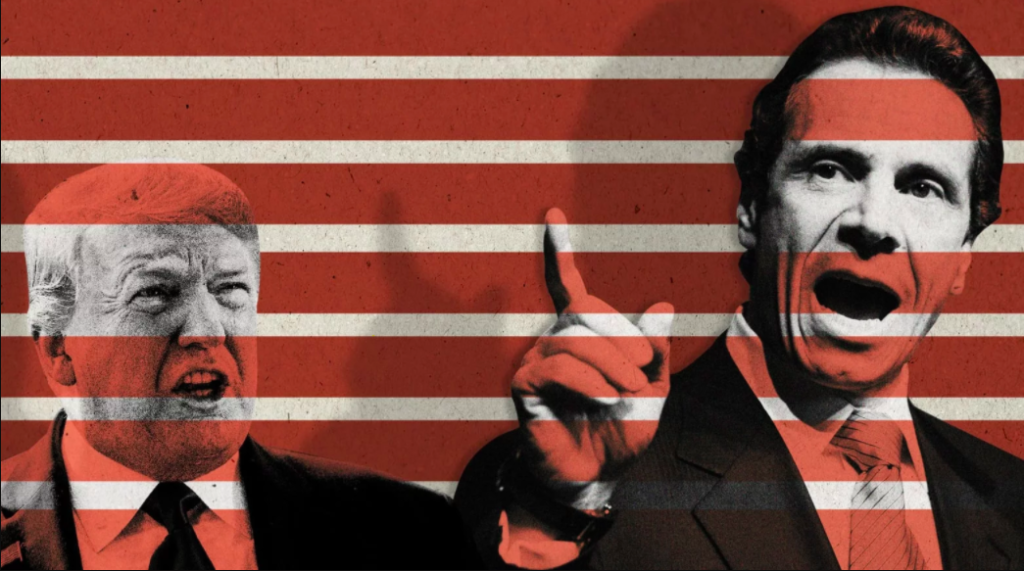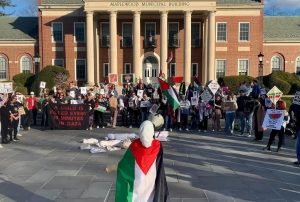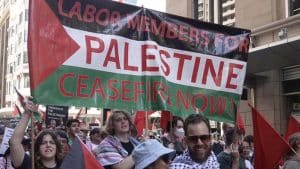The Trump administration went from outright denial of the pandemic to warning that the United States had become one of the epicenters of the pandemic. The government now insists that “we are all in this together.” But the crisis has exposed both the social and political fragmentation that is the product of four years of the Trump administration, as well as decades of neoliberalism and globalizing discourse. In this context, the ability to achieve national unity in the face of the pandemic appears to be a difficult challenge, both for the government and its opposition.
Global Crisis and Internal Weakness: U.S. Imperialism in Trouble
On the external front, the decline of U.S. hegemony has deepened, highlighting the United States’ inability to achieve a coordinated international response in both health and economic terms. Trump’s erratic international policy has cooled relations with China, his Middle Eastern allies, as well as the European Union. Both corporations and bourgeois analysts have warned about the inability of the ruling class to lead the crisis. Among them is former Secretary of State and strategist Henry Kissinger, who warns in the Wall Street Journal that the world is facing a new era and the U.S. must lead an international response and unite a divided country.
The concern over purely national responses to the health and economic crisis and the need to “safeguard the liberal world order” shows the fear of a breakdown of the capitalist order, fuelled by the promise of a new Great Depression. On the other hand, as Janan Ganesh points out in the Financial Times, neither China nor Europe, which were the first epicenters of the pandemic, have been able to lead an alternative front to the United States. The course of the outbreak and their governments’ responses to it have also revealed the internal social and regional inequalities in these regions. Meanwhile, the only thing the imperialist powers have agreed on is suffocating the poorest countries in Latin America, Africa, and the Middle East with debt and sanctions. While the whole planet is affected by the virus and the irrationality of the capitalist system, inter-state tensions show the inability of a system that prioritizes the profits of a minority over billions of lives to find a way out of the present crisis.
External hegemony is as necessary for internal national unity as the other way around. If there is something that has driven the big national companies in the last decades, it is, as Perry Anderson explains in American Foreign Policy and Its Thinkers: the ability to make both factors coincide under the idea of an external threat, identifying the interests of the expansionist bourgeoisie with those of the nation and disciplining the external frictions with the more isolationist bourgeois sectors, focused on the internal market. It is not by chance that the media and officials refer to the national unity achieved with the Second War or after 9/11. The mantra that “we are all in this together” is more a wish than a reality, in the face of the divisions in the ruling class and the evidence of regional, social, and racial inequalities with the impact of the crisis.
In this sense, Trump faces an open crisis on the health front and the collapse of the official narrative he built around the growth of the economy, which highlighted the reduction of unemployment and tactical victories in the international arena, including the beginning of an agreement with China to end the trade war.
Now it’s all gone up in smoke. Wall Street criticized the fact that many government statements dismissed the virus at first, leading to a downturn in the markets (even though speculators and bankers were the first to benefit from the bailouts, as were the oil companies). Weak attempts at state intervention, such as the Defense Protection Act put pressure on big industries like the automobile and pharmaceutical industries. Though Trump has invoked this measure, he has only partially put it into practice for the occasional production of respirators, tests, and medicines. In no way has this resulted in a sufficient level of centralization to confront the expansion of COVID-19.
Instead, the government must arbitrate between these industrial sectors (those most favored during Trump’s presidency by tax exemptions and tax relief) and those who were the basis of his electoral victory — farmers engaged in domestic trade, manufacturing companies, small industries, and also among blue-collar workers who were economically hit by the deterioration of the industrial areas. Farmers have already begun to show signs of discontent and pressure against the government. In California they are threatening to fire rural workers. Other farmers have thrown milk and eggs on their fields in Arizona, Wisconsin, Utah, and Idaho, saying they cannot sell it. They are punishing workers and wasting resources while millions of people fall into poverty and unemployment as a result of the crisis.
Trump, Cuomo, and the Governors
Democrats and Republicans reached agreements such as the $2 billion bailout, which was approved with the support of the entire political spectrum, including Bernie Sanders. The core of this agreement is the bailout of large corporations and banks, but it also included money for small businesses and a single time $1,200 check for those over 18 (excluding a wide swath of people, including undocumented immigrants). Despite these agreements, the divisions amongst the ruling class are deepening.
The health crisis, in combination with regional and racial inequalities, as well as the impact of the economic crisis on productive activity and employment, exacerbates tensions in the nation’s superstructure. These tensions are as much about resources as they are about managing the pandemic and coming out of the crisis in a strong position. Within this framework, Trump has taken a series of bonapartist measures in the institutional field, such as the removal of Glenn Fine, director of the Pandemic Response Accountability Committee, who was formerly in charge of controlling the non-discretionary use of emergency funds. He has also demanded that the World Health Organization (WHO) investigate China and hold it responsible for the pandemic.
Trump’s measures contradict the narrative that his administration is trying hard to push, namely that the government has been a good steersman in the face of the pandemic. Even with Trump’s hesitancy to acknowledge the public health crisis, the concessions he made to workers and small businesses, and the inability of the Democratic Party to put forward a strong candidate, Trump still holds a broad base of support. However, elections are still a long way off as the country passes through the peak of the pandemic. Trump’s re-election is not guaranteed, nor is the consensus around the slogan “We’re all in this together.” The unity Trump is calling for is meant to secure the profits of billionaires and to maintain the structural inequities that are leading to illness and death for millions of working people and the poor, especially those most vulnerable, such as Black and Latinx people.
As an alternative to the federal government’s zig-zagging response, New York Governor Andrew Cuomo emerged as a strong leader. The Democrat has gained popularity by challenging Trump’s unwillingness to provide states with sufficient resources to combat the outbreak. Further, though today New York State and particularly New York City are the epicenter of the coronavirus, Cuomo has set a goal of returning to activity by early May. Cuomo is positioning himself as a leader capable of managing the crisis and thus containing the anger and possible deepening of protests that are already being seen among health care workers, supermarket workers, and other essential sectors. It remains to be seen whether this political capital can play in the favor of Joe Biden, who has been largely absent during the pandemic. Today Cuomo has a better image than Biden, but he has said that he has no intention of leaving the governorship; further, to be the candidate he would have to surmount the obstacle of being nominated at the DNC without having participated in the primaries. Some media are so fanatical about Cuomo that they even call him “de facto president.” Both the New York governor and Biden want to use the speech of national unity for the Democratic establishment’s advantage, but they have no intention of taking such minimal and indispensable steps as intervening in the private health care system, banning layoffs, or providing even minimal protection for those on the front lines.
Beyond Sanders: The Workers Unity We Need
Bernie Sanders has joined this chorus of unity along with the establishment which he had been so determined to fight. The establishment managed to play dirty enough to demolish the senator’s bid for the candidacy, and now he has dropped out of the race to support Biden, a friend of the pharmaceutical companies. Sanders did so without his central proposal of Medicare for All being taken up by the party as a whole. Sanders and his supporters on the left talk about winning the ideological battle, but although millions support demands like Medicare for All, Sanders’ strategy was a failure. In the end, his inside-out strategy — to change the Democratic Party with grassroots pressure in the streets — ultimately resulted in neither inside, nor out. Neither is Sanders in the presidential race, nor did the establishment take up his ideas; Sanders did not mobilize and organize the strength of thousands of workers, students, unions, and social movements that support him in order to win free health care at a time when it is literally life and death for millions of people. Instead, he renewed the decadent Democratic Party by strengthening the idea that no alternative is possible outside capitalist parties.
Despite Sanders’ leadership, the movement that was formed around his ideas, and which is made up of many young students, teachers, nurses, and social activists who define themselves as socialists, will not necessarily follow orders. It is encouraging that young socialists from the DSA have spoken out against support for Joe Biden, and it is also encouraging that struggles have begun by health care workers, employees of Amazon, Whole Foods, and Instacart. General Electric workers have demanded that they convert production in their factories to produce much-need respirators. It is not only time to organize solidarity and a response to the pandemic but also to draw a necessary political conclusion: we need our own party, a working class party. If this pandemic has proved anything, it is that it is the workers who are sustaining the fight against the pandemic — who are caring, feeding, producing, and risking their lives.
Unemployment, racism, nationalist prejudices, the atomization of the unions, and sexism threaten the unity of the workers. The unity we need is not that of workers and students behind the bourgeoisie and capitalist officials, but the broadest and most powerful unity possible among all workers. For this it will also be necessary to fight so that unions are transformed into true levers of independent working class organization. We must aim, not only to survive the pandemic, but also to create our own political way out, organizing the response to this crisis as well reconfiguring society for the vast majority.










